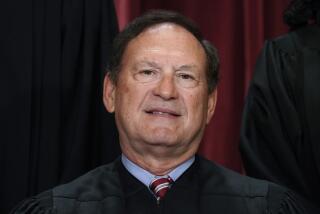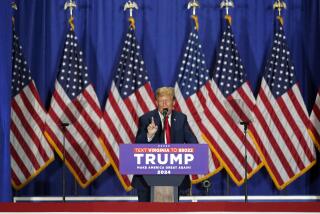The evolving Supreme Court
Ayear ago, when the U.S. Supreme Court finished its second term under Chief Justice John G. Roberts Jr., the court was criticized -- including on this page -- for giving the lie to Roberts’ paeans at his confirmation hearings to consensus and respect for precedent. Twenty-four cases were resolved by 5-4 votes, and on some key issues there was no majority at all. Far from respecting precedent, the Roberts court in its 2006-07 term executed unseemly U-turns on two issues, approving a federal ban on “partial-birth” abortions and overriding school districts that sought to achieve a modicum of racial integration in the classroom.
Last week, the court ended its 2007-08 term, still reckless in its treatment of precedent but more in line with Roberts’ comments about consensus. We say this even though three of the most significant cases were decided 5 to 4 on predictable ideological lines: the invalidation of the District of Columbia’s gun-control law, turning decades of precedent upside down; a ruling that the death penalty may not be imposed on child rapists; and a rejection of the Bush administration’s and Congress’ view that detainees at Guantanamo Bay lack the protections of habeas corpus.
Those decisions may be the exceptions that prove the rule of a more collegial court. According to a calculation published on ScotusBlog, the percentage of 5-4 decisions this term was roughly half of what it was last term. Even the D.C. gun decision, which we deplored, was more cautious and modest in its rhetoric than one would have expected from an opinion written by the strident Justice Antonin Scalia. Was a more circumspect majority opinion the price Scalia had to pay for the signatures of Roberts and Justice Samuel A. Alito Jr.? It’s impossible to know, but in other cases, President Bush’s two appointees redeemed somewhat their reputation for uncritical allegiance to a conservative political agenda.
For example, Alito joined with the court’s liberals in holding that the Age Discrimination in Employment Act protected workers against retaliation for lodging discrimination claims. Roberts joined the liberals (and Scalia and Anthony M. Kennedy) in upholding a judge’s show of leniency for a college student who reformed after being involved in a drug ring. And not all of the bridge building came from the right of the court. Justice David H. Souter, a liberal, wrote the opinion in last week’s ruling to reduce the punitive damages assessed on Exxon Mobil Corp. in the Exxon Valdez oil spill. Another liberal, Justice John Paul Stevens, joined conservatives in upholding Indiana’s requirement that voters present a photo ID.
Of course, consensus isn’t the only virtue -- or even the greatest virtue -- in jurisprudence. Advocates of civil liberties rightly would prefer a 5-4 vote affirming habeas rights for Guantanamo detainees to a unanimous decision denying such rights. Still, the legitimacy of the court over time is undermined by a perception that it is just another political arena in which liberals spar with conservatives on the basis of preconceived notions.
That is something we hope John McCain and Barack Obama will keep in mind. It is entirely appropriate for presidential candidates to comment on Supreme Court decisions and to indicate in general terms what sort of people they would appoint to the bench. (McCain has promised to nominate “judges who understand that their role is to faithfully apply the law as written, not impose their opinions through judicial fiat.” Obama has said he will seek justices with “heart” and “empathy” for the poor and minorities.) But would-be presidents should be careful not to suggest that they will appoint ideologically predictable automatons. Whatever one thinks of particular decisions, the court plays a vital role in ensuring that the Constitution, not public opinion or political expediency, has the last word.
More to Read
A cure for the common opinion
Get thought-provoking perspectives with our weekly newsletter.
You may occasionally receive promotional content from the Los Angeles Times.






